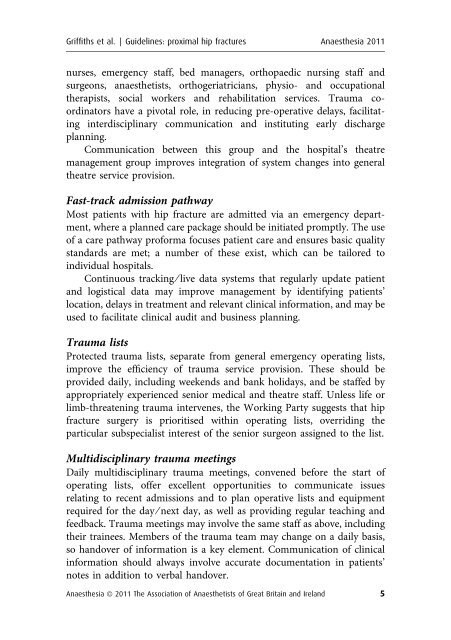Management of Proximal Femoral Fractures 2011 - aagbi
Management of Proximal Femoral Fractures 2011 - aagbi
Management of Proximal Femoral Fractures 2011 - aagbi
Create successful ePaper yourself
Turn your PDF publications into a flip-book with our unique Google optimized e-Paper software.
Griffiths et al. | Guidelines: proximal hip fractures Anaesthesia <strong>2011</strong>nurses, emergency staff, bed managers, orthopaedic nursing staff andsurgeons, anaesthetists, orthogeriatricians, physio- and occupationaltherapists, social workers and rehabilitation services. Trauma coordinatorshave a pivotal role, in reducing pre-operative delays, facilitatinginterdisciplinary communication and instituting early dischargeplanning.Communication between this group and the hospital’s theatremanagement group improves integration <strong>of</strong> system changes into generaltheatre service provision.Fast-track admission pathwayMost patients with hip fracture are admitted via an emergency department,where a planned care package should be initiated promptly. The use<strong>of</strong> a care pathway pr<strong>of</strong>orma focuses patient care and ensures basic qualitystandards are met; a number <strong>of</strong> these exist, which can be tailored toindividual hospitals.Continuous tracking ⁄ live data systems that regularly update patientand logistical data may improve management by identifying patients’location, delays in treatment and relevant clinical information, and may beused to facilitate clinical audit and business planning.Trauma listsProtected trauma lists, separate from general emergency operating lists,improve the efficiency <strong>of</strong> trauma service provision. These should beprovided daily, including weekends and bank holidays, and be staffed byappropriately experienced senior medical and theatre staff. Unless life orlimb-threatening trauma intervenes, the Working Party suggests that hipfracture surgery is prioritised within operating lists, overriding theparticular subspecialist interest <strong>of</strong> the senior surgeon assigned to the list.Multidisciplinary trauma meetingsDaily multidisciplinary trauma meetings, convened before the start <strong>of</strong>operating lists, <strong>of</strong>fer excellent opportunities to communicate issuesrelating to recent admissions and to plan operative lists and equipmentrequired for the day ⁄ next day, as well as providing regular teaching andfeedback. Trauma meetings may involve the same staff as above, includingtheir trainees. Members <strong>of</strong> the trauma team may change on a daily basis,so handover <strong>of</strong> information is a key element. Communication <strong>of</strong> clinicalinformation should always involve accurate documentation in patients’notes in addition to verbal handover.Anaesthesia ª <strong>2011</strong> The Association <strong>of</strong> Anaesthetists <strong>of</strong> Great Britain and Ireland 5
















